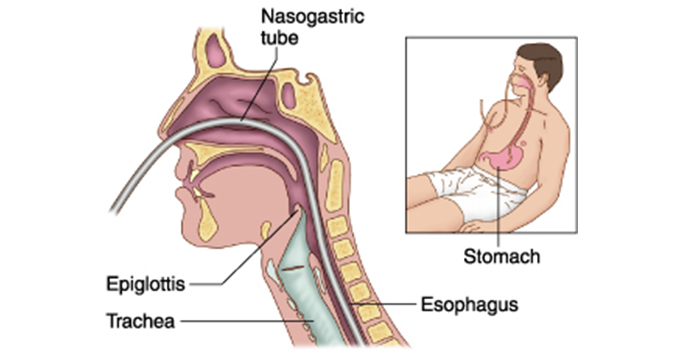Nasogastric Intubation
Nasogastric Intubation:- Gastric intubation via the nasal passage (i.e., nasogastric route) is a common procedure that provides access to the stomach for diagnostic and therapeutic purposes. A nasogastric (NG) tube is used for the procedure. The placement of an NG tube can be uncomfortable for the patient if the patient is not adequately prepared with anaesthesia to the nasal passages and specific instructions on how to cooperate with the operator during the procedure.
Indications
Diagnostic indications for Nasogastric Intubation include the following:
- Evaluation of upper gastrointestinal (GI) bleeding (i.e., presence, volume)
- Aspiration of gastric fluid content
- Identification of the oesophagus and stomach on a chest radiograph
- Administration of radiographic contrast to the GI tract
CLICK HERE for more resources on Fundamentals of Nursing
Therapeutic indications for Nasogastric Intubation include the following:
- Gastric decompression, including maintenance of a decompressed state after endotracheal intubation, often via the oropharynx
- Relief of symptoms and bowel rest in the setting of small-bowel obstruction
- Aspiration of gastric content from recent ingestion of toxic material
- Administration of medication
- Feeding
- Bowel irrigation
Contraindications
Absolute contraindications for Nasogastric Intubation include the following:
- Severe midface trauma
- Recent nasal surgery
Relative contraindications for Nasogastric Intubation include the following:
- Coagulation abnormality
- Oesophageal varices or stricture
- Recent banding or cautery of oesophageal varices
- Alkaline ingestion
Complications
The main complications of Nasogastric Intubation include aspiration and tissue trauma. Placement of the catheter can induce gagging or vomiting, therefore suction should always be ready to use in the case of this happening.
Universal precautions:
The potential for contact with a patient’s blood/body fluids while starting an NG is present and increases with the inexperience of the operator. Gloves must be worn while starting an NG; and if the risk of vomiting is high, the operator should consider face and eye protection as well as a gown. Trauma protocol calls for all team members to wear gloves, face and eye protection and gowns.
Equipment:
All necessary equipment should be prepared, assembled and available at the bedside prior to starting the NG tube. Basic equipment includes:
- Personal protective equipment
- NG/OG tube
- Catheter tip irrigation 60ml syringe
- Water-soluble lubricant, preferably 2% Xylocaine jelly
- Adhesive tape
- Low powered suction device OR Drainage bag
- Stethoscope
- Cup of water (if necessary)/ ice chips
- Emesis basin
- pH indicator strips
CLICK HERE for Free NCLEX –RN & CGFNS Practice Questions
Procedures:
- Gather equipment
- Use sterile gloves.
- Explain the procedure to the patient and show equipment.
- If possible, sit patient upright for optimal neck/stomach alignment.
- Examine nostrils for deformity/obstructions to determine best side for insertion.
- Measure tubing from bridge of nose to earlobe, then to the point halfway between the end of the sternum and the navel.
- Mark measured length with a marker or note the distance.
- Lubricate 2-4 inches of tube with lubricant (preferably 2% Xylocaine). This procedure is very uncomfortable for many patients, so a squirt of Xylocaine jelly in the nostril, and a spray of Xylocaine to the back of the throat will help alleviate the discomfort.
- Pass tube via either nare posteriorly, past the pharynx into the oesophagus and
then the stomach. - Withdraw tube immediately if changes occur in patient’s respiratory status, if
tube coils in mouth, if the patient begins to cough or turns pretty colours. - Advance tube until mark is reached.
- Check for placement by attaching syringe to free end of the tube, aspirate sample of gastric contents. Do not inject an air bolus, as the best practice is to test the pH of the aspirated contents to ensure that the contents are acidic. The pH should be below 6. Obtain an x-ray to verify placement before instilling any feedings/medications or if you have concerns about the placement of the tube.
- Secure tube with tape or commercially prepared tube holder.
- If for suction, remove syringe from free end of tube; connect to suction; set machine on type of suction and pressure as prescribed.
- Document the reason for the tube insertion, type & size of tube, the nature and amount of aspirate, the type of suction and pressure setting if for suction, the nature and amount of drainage, and the effectiveness of the intervention.
Instruct the patient to swallow (you may offer ice chips/water) and advance the tube as the patient swallows. Swallowing of small sips of water may enhance passage of tube into oesophagus.
If resistance is met, rotate tube slowly with downward advancement toward closes ear. Do not force.
Sources:
Med Uottawa
Medscape


That was great thank you. Just one or two letter omission along. Really use full to me in particular.